Caribbean cruise: The most beautiful harbours and bays in the British Virgin Islands
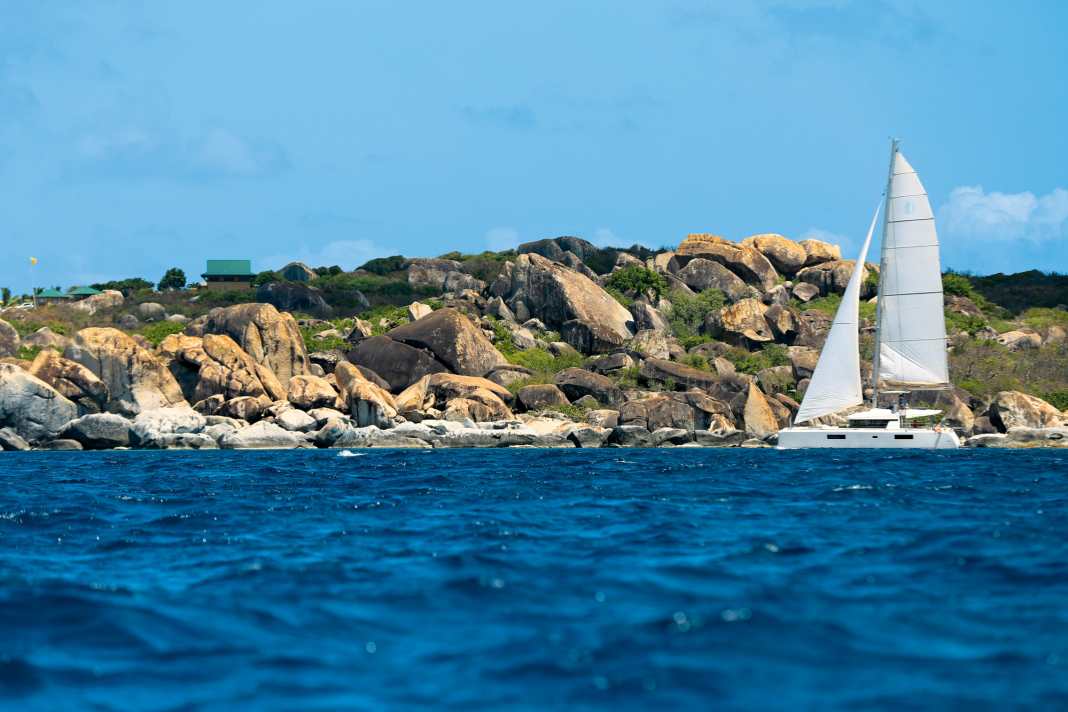





Caribbean special:
A brief portrait of Caribbean destinations:
There's no question that the Caribbean is a popular charter destination. However, the individual island groups differ greatly. While the infrastructure in some regions is very basic and you can still discover a piece of the original, undeveloped Caribbean, others have been completely conquered by tourism. Such as the British Virgin Islands (BVIs). But that's not a bad thing, on the contrary.
For example, there are plenty of mooring buoys available at every swimming and stage stop, and there are also a few good restaurants everywhere. Shops and places of interest are often within walking distance when going ashore. And a great beach with an award-winning bar is never far away. What's more, the sailing distances are short and the area is extremely sheltered.
The BVIs are a leisure park for sailors
"If Walt Disney had designed a theme park for sailors, it would probably look like the BVIs," a US sailor tells us. Many of them walk and sail around here, the islands are their Mallorca thanks to a two and a half hour flight from the US east coast. What's more, the island chain, which stretches from east to west over just 27 nautical miles, has a lot to offer. Many Americans therefore leave their boats here all year round.
This is not normally risky, as the BVIs are very rarely hit by a hurricane. But then came "Irma" in September 2017, which hit the islands with full force and caused major destruction. The area has been slow to recover from the shock. At the time, YACHT reported on the disaster and its consequences. Now we were back on site to find out how far the reconstruction has progressed. And whether the islands still exude the same charm as they did back then.
The shores are still lined with wrecked and upside-down catamarans.
On the way from the ferry terminal in Road Town to the charter base in the east of the island of Tortola, the first remnants of the hurricane catch the eye. The road leads past Paraquita Bay, a "hurricane hole" in which charter companies wanted to secure well over 100 charter boats from "Irma". None of them survived. The shores are still lined with wrecked and upside-down catamarans.
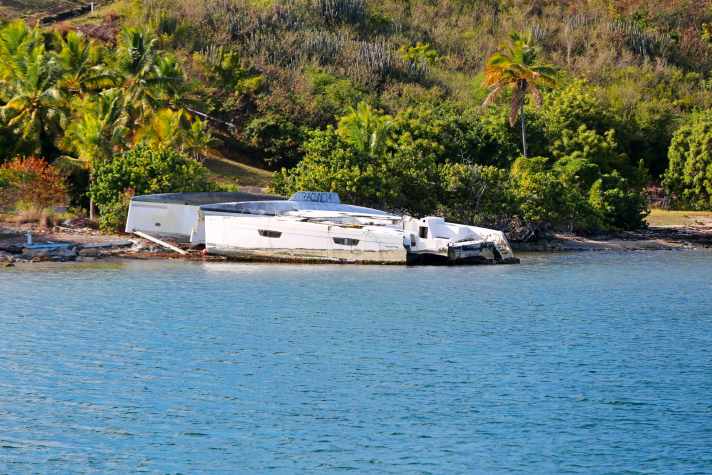
Catamarans have conquered the British Virgin Islands
At the Dreamyachtcharter base, we take over our Lagoon 52 "Rhapsody" at 5 p.m. on the dot, which will take us through the islands for nine days. Monohulls have become rather rare on the Caribbean charter market, cats have conquered the territory. And hardly any ship is more than five years old - another consequence of the hurricane. The "Rite-Way" supermarket has already delivered the provisions ordered online from home and even chilled the first drinks. There is even an Internet router on board, making the tiresome search for local SIM cards superfluous. However, at 190 US dollars for nine days, the data package is not cheap. But the next morning we can set off without delay. Charter base employee Teka instructs us on the boat's special features and then shows us the ideal line ahead in the dinghy so that we can safely pass the reef surrounding the harbour with the cat.
The first leg should be a short one. Although the BVIs are under the influence of the trade winds, which means there is usually a steady easterly wind, it is calm. We therefore motor eight and a half nautical miles past Peter Island and the small rock The Indians over to The Bight. It is located on Norman Island and was supposedly the setting for Robert Louis Stevenson's book "Treasure Island". However, apart from an old rusty cannon on the beach, there are no reminders of the pirate days. Instead, the large bay is dotted with dozens of mooring buoys. The "Willy T", a floating bar that can only be reached by boat, is anchored in the north. Despite the large number of yachts, the wide beach in the far east of the bay is deserted in the afternoon. This is despite the fact that you can watch one of the most beautiful sunsets from here.
A Painkiller at the Bitter End Yacht Club to kick things off
The Bitter End Yacht Club is located far to the east of the archipelago. The "bitter end" describes the end of a rope that must not slip out of the block. The name was presumably intended to describe the secluded location of the club. Indeed, on the cross against the trade wind, it feels as if you have to go to the end of the world. Yet another marina opened behind the yacht club in 2023: Oil Nut Bay has 93 berths and a number of small restaurants.
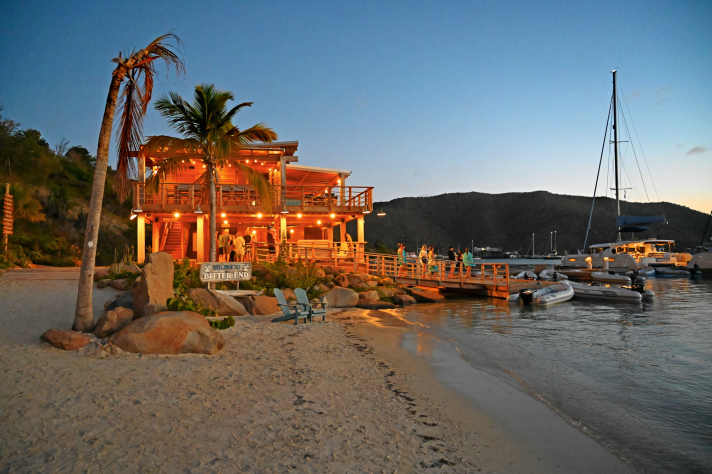
The Bitter End yacht club was a total loss after Hurricane Irma and had to be completely rebuilt. The work is not yet complete, but the marina, petrol station, restaurant and beach bar in the shape of an old motorboat are back in operation. The bare wooden walls without any paint give an idea of the haste with which the reconstruction work was carried out. Most of the sailors don't care, they still take "their medicine" here for the first time after the long journey: a Painkiller, the cocktail for which the BVIs are famous. It is made from coconut cream, pineapple and orange juice and dark rum, served over ice and with freshly grated nutmeg.
Murings instead of anchoring to protect the seabed
In the BVIs, the boats are moored at murings, which cost 30 to 40 dollars per night, regardless of the size of the boat. This is to protect the underwater world from hundreds of anchors. What's more, a buoy field can accommodate more yachts in the same space. This is important in the high season.
However, there are also opportunities for a lonely night at anchor. For example, in the extremely sheltered Savannah Bay, around six and a half nautical miles away and north-east of Spanish Town. A long sandy beach invites you to swim and linger, even if there are no palm trees to provide shade.
The Baths rock formation is a must-see
Savannah Bay has another advantage as an overnight stop: from here it is only two and a half nautical miles to the rock formation The Baths on Virgin Gorda, the most spectacular scenery the BVIs have to offer. It's as if a giant had been playing with pebbles on the beach. However, landing is not easy: it is a half-hour hike from the anchorage off Spanish Town to the entrance of the park, and the day mooring buoys directly in front of the rocks are highly coveted and rare. That's why it's worth getting up early - or taking the short route. On site, the buoyed bathing area around the rocks is off-limits to dinghies. So the only option is to pack your mobile phones in waterproof bags and swim back to the shore. Take some cash with you, as admission costs ten US dollars.
After a long day of climbing and splashing around - you feel like a little kid again in The Baths - nobody on board wants to do any more miles. But the Muring has to be left before nightfall, so the route continues five nautical miles to Trellis Bay behind Beef Island. This is the bay that is brought to life once a month by artists and fire performers during the Full Moon Festival. But it's half moon right now, so the bay is empty.
The best chicken roti in the Caribbean awaits in Trellis Bay
If you want to try typical Caribbean food, a visit to Trellis Bay Market is worthwhile. Here you can find simple but authentic dishes. For example, the chicken roti, a kind of Caribbean kebab with sweet potatoes and meat, all wrapped in a corn patty and served with mango chutney. It was recently voted the best in the Caribbean.
On the other side of the archipelago is Jost van Dyke, named after a Dutch privateer. The island is not far away, just ten nautical miles downwind to the west. Then Sandy Spit is already in front of the bow pair. The sandy island with its two palm trees is a postcard motif. During the day, Sandy Spit has to be shared with other sailors. In the early morning and late evening, however, there is even a bit of a private island feeling. During the night, however, it can get restless at anchor here, so we later move to a mooring buoy at "Foxy's Taboo", which can now even be reserved online - and should be. Via boatyball.com.
The next day, we set course for the west of Jost van Dyke. It is said that the Painkiller was invented here, in White Bay. The "Soggy Dollar Bar" has been here since the seventies and has just been rebuilt after the hurricane. The name says it all, as there is no jetty. Thirsty sailors can only get ashore in their swimming trunks - with a "wet dollar" in their pocket. Or by dinghy. Finding a place for the cat is difficult, however, as the anchorage is very crowded. Only when the day trippers head back to Tortola in the evening does it become more airy.
Seclusion on Jost van Dyke, colourful hustle and bustle in Soper's Hole
Despite the many boats, the crowds get lost on the beach. Nobody queues for long at the bar either. For the sake of simplicity, the famous original Painkiller is pre-mixed from former gallon water cans and poured over ice cubes, then topped up with Pusser's Rum. The secret of the flavour is probably the scenery all around anyway: the turquoise water, the fine sand between your toes and a crowd of sociable other sailors who are all here for the same reason. Cheers!
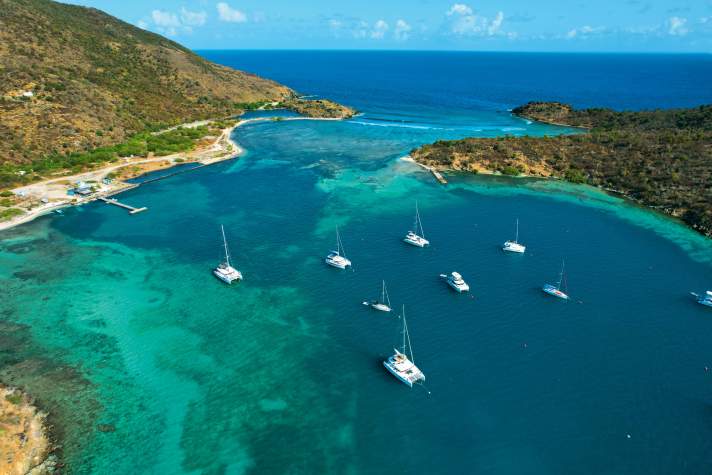
Anyone who gets out of bed the next morning and finds a pile of empty cups in the dinghy has probably overdone it the day before. Fortunately, the next destination is once again not far away, only five nautical miles. Although it could be a few more due to a cross course. In Soper's Hole, we are suddenly back in civilisation. The colourful house front of The Wharf looks almost picturesque in the evening sun, as if painted. The dinghy takes us ashore, where there is a wide range of cafés, restaurants and cocktail bars. There is also a supermarket right by the harbour.
After the hurricane, many marinas were completely reorganised
Then it's time for the last leg: Along the south coast of Tortola, we cruise eastwards against the trade winds and leave our wake off Norman Island. After just 100 nautical miles, we have rounded the British Virgin Islands! For the last night, we fish for a mooring buoy in the north of Cooper Island, directly opposite the beach club, which has been developed into an eco-resort in recent years.
Many operators have used the time after the hurricane damage to modernise or completely rebuild their hotels and marinas. Cooper Island is now focussing on self-sufficiency. Among other things, they brew their own beers: "Caribbean IPA", "Tropical Lager", "Sunset Pilsner". We try them all, and none of them seem out of place here with the view of the Caribbean Sea. The only annoying thing is the field of Sargasso seaweed that has now formed around all the boats moored in front of Muring. This is a problem that has been increasing in the Caribbean in recent years.
The next morning, it's just a stone's throw back to the charter base. We therefore use the last day of sailing to let the ship run once more. After all, who wants to go home when you can be out and about in an adventure playground like the BVIs!
Area information British Virgin Islands
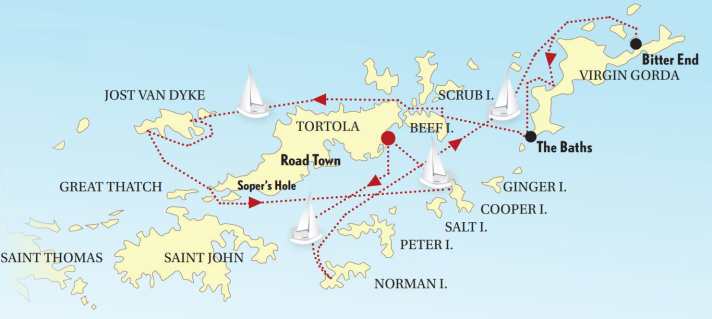
Charter
We were travelling on a Lagoon 52 from Dreamyachtcharter, which we chartered through Barbera-Yachting. The boat cost 19,200 euros for nine days. Most charter boats are catamarans, monohulls are hardly available in the area. Info:
The precinct
The British Virgin Islands are considered the easiest Caribbean destination. They are also very safe and family-friendly. The more than 60 islands are close together and no border crossing is required anywhere.
Wind &Weather
The archipelago is exposed to the trade winds and has a pleasant climate all year round. The best months to visit are April, May and November. During the hurricane season (June to October), the weather is often unstable.
Journey
There are two ways to get to the British Virgin Islands: either via Paris to St Martin and then by propeller plane to Tortola. Or you can choose the route via the USA (Esta visa required) to St Thomas in the US Virgin Islands and from there by ferry to the BVIs. Direct flights are not possible. Return flights cost between 900 and 1,000 euros.
Berths
Most of the bays are covered with mooring fields. The night costs between 30 and 40 US dollars and there are plenty of buoys available.
Literature
"Cruising Guide to the Virgin Islands" by Simon Scott, 39.80 euros, available from specialist bookshops.

